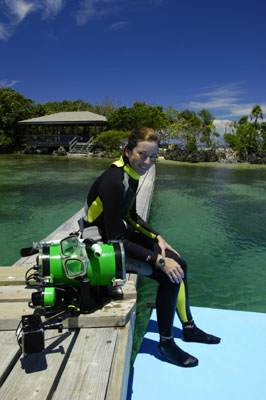
Dolphin Communication
Questions for Researching Dolphin Communication
Questions contributed by Kathleen M. Dudzinski, Ph.D. on June 3, 2008 in response to QFL's interview question:
"What are the five to ten primary questions which you ask yourself in the process of understanding and documenting dolphin communication signals?"
How do dolphins share information? That is, what modes of signal exchange (communication) do they use under different contexts?
All animals (including humans) communicate or share information. Without communication, we could not live in complicated societies or coordinate activities. There are many similarities among social animals in how they share information. Our (human) experience is primarily terrestrial, so I have been intrigued to see whether dolphins, as aquatic social mammals, are more similar to terrestrial animals or more different in how they share information, in how they communicate.
What is acceptable behavior (etiquette) among dolphins?
Studying dolphins is like studying an iceberg: they live in an environment that humans can only visit for brief stints. To collect long-term, longitudinal observations of the behavior of another species we must spend a lifetime to study these long-lived social mammals. It is hard, if impossible, to hide when studying dolphins... so, we strive to be non-invasive in an attempt to not break the rules of dolphin society that we do not understand in detail.
Understanding how dolphins behave with each other will shed light on how to best manage the behavior and actions of people who seek out interactions with dolphins.
Is it possible to get dolphins to mostly ignore me in the role of observer?
I try to be as non-invasive as possible when studying dolphins. I do not chase, do not touch. I'd prefer if dolphins actually ignored me since I want to study dolphin-dolphin interaction and communication.
Do dolphins exhibit distinct, individual traits (i.e., "personalities")?
Over the years, I have observed different individual dolphins and different ages and sexes of dolphins behave in subtly differing ways. The hundreds of hours of observations suggest to me that dolphins have unique character traits - what would be called personalities in humans. Some moms are very attentive, others not so much. Young dolphins are more rambunctious than older individuals. Some dolphins are more daring while others could be described as more timid.
How can I introduce interested non-scientists to the reality of dolphins, to what they are as a social animal as opposed to what Hollywood and the media has depicted?
The facts about dolphin society, communication and cognition are so much more interesting that the fanciful stories often promoted through mass media.
What are the patterns in dolphin behavior, in dolphin vocalizations, in their activity? Will these patterns provide a window to their minds?
I have been documenting dolphin behavior and sounds since 1991. Even now, when I review footage that is more than 15 years old, I find subtle nuances that I missed previously. Examining the video and audio data is our avenue into finding patterns in dolphin behavior and interactions. We are beginning to understand their world, on their terms... but we have a long way to go. Studying dolphin behavior is like putting together a gigantic jigsaw puzzle for which you have lost the box and cover picture.
Additional information can also be found at the following links:
Dolphin Communication - Podcast
'Dolphin Language" - Podcast
Dolphin Personalities - Podcast
Dolphin Vocalizations - Podcast
Info Regarding: behavior, cognition & intelligence - Podcasts


Kathleen Dudzinski
Bio
Dr. Kathleen Dudzinski has been studying dolphin behavior and communication since 1990 with a focus on tactile, behavioral and acoustic signals employed by dolphins as they share information with each other and across groups. Dr. Dudzinski is Director of the Dolphin Communication Project (DCP), conducts research on three groups of dolphins in both captive and wild environments, and oversees research conducted by graduate students from five universities who collaborate with DCP. Students focus on the behavior, acoustics and communication among and between dolphins residing at four locations around the globe: two wild dolphin populations near (Atlantic spotted dolphins) Bimini, The Bahamas and (Indo-Pacific bottlenose dolphins) Mikura Island, Japan and two groups of dolphins in human care (both bottlenose dolphins) at the Roatan Institute for Marine Sciences (RIMS), Anthony's Key Resort, Roatan, Honduras and at Dolphin Encounters, Nassau, The Bahamas.
In 2000, Dr Dudzinski's work studying dolphins was featured in the large-format film DOLPHINS from MacGillivray Freeman Films (2000) for IMAX theaters. In the same year, her first book for children, Meeting Dolphins My Adventures in the Sea, was published from National Geographic Books. Since then, Dr. Dudzinski has also consulted on several documentary films, magazine articles and other projects. Dr. Dudzinski's next book on dolphin communication is slated for publication from Yale University Press in fall 2008.


